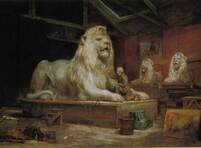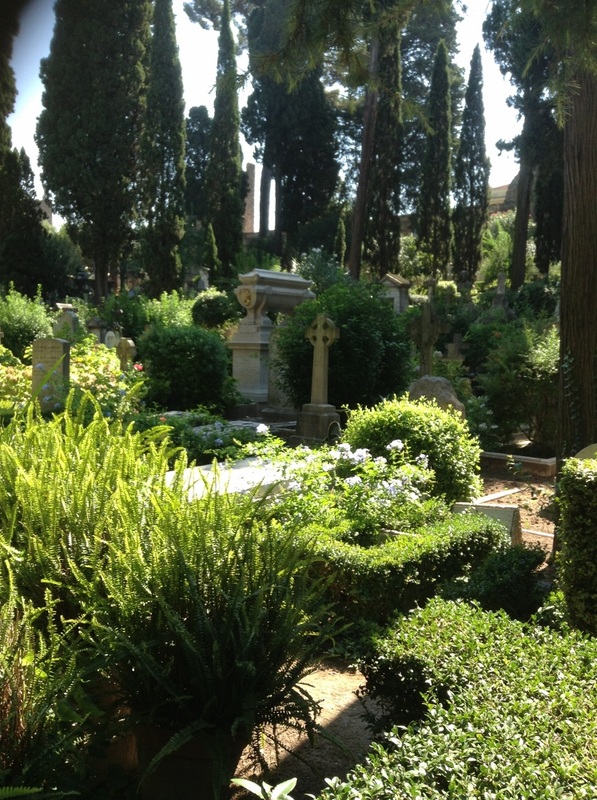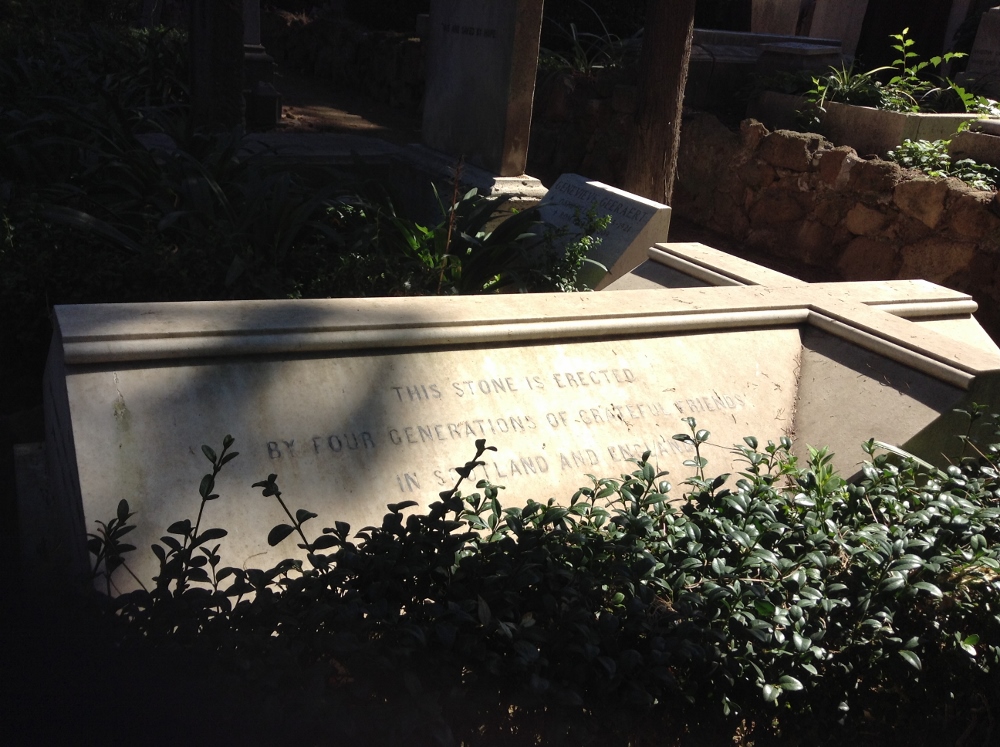IntroductionThis instalment follows on from where I left off last time, looking at the various families with connections to Lennelhill. However, this time another family is being brought into the mix with no apparent connections to the farm itself but through marriage may have made a lasting impression none the less. Although I only describe here the connection in the context of the families we have already met, their genes are spread far and wide throughout many other well known Border family names! The research process for this chapter has been far from simple and I must extend my most sincere thanks to my friend and colleague, Alison Elliott in Australia for the fantastic job she has done on this fact-finding mission!! So without further ado more Ballantynes..... The PainterChristina Alice Hogarth, sister to the Hogarth brothers who were lost on "The Royal Charter" married John Ballantyne, her second cousin, nephew to James & John Ballantyne whose lives were so immersed with that of Sir Walter Scott. John's father was Alexander, the youngest of the three brothers, who was also in the printing business purchasing his brother James's interest in the "Kelso Mail" in 1806 to become its sole owner. Whilst not so heavily involved with Sir Walter as his brothers, the failure of their respective businesses still left "Sandy" somewhat financially embarrassed. 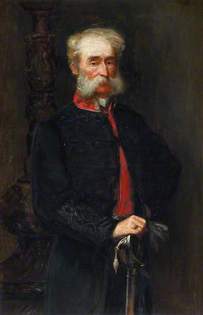 John Ballantyne (1815-1897) John Ballantyne (1815-1897) John was born in Kelso in 1815, one of ten children born to the above Alexander Ballantyne and his wife Anne "Randall" Scott Grant, and one of eight surviving childhood. John received his artistic training at the Trustees Academy in Edinburgh before travelling extensively throughout Europe. Returning to Edinburgh in 1839 he established himself as a portraitist and regularly exhibited at the Royal Scottish Academy, to which he was elected an associate member in 1841, and full member in 1860. During this period John played a significant part in the Edinburgh art world, but by 1860 was in serious financial distress. With portrait painting out of fashion, a wife and three children to support, the family moved to London in 1863, where he taught and sought to re-establish his reputation by painting famous London artists at work in their studios. Although these paintings were highly acclaimed and form his most exhibited works today, they failed to realise much in the way of revenue. This series proved to be his last major work, his eyesight was starting to fail and by the mid 1880's he was unable to paint at all. His brother Robert a succesful author of boys literature and to whom he was close continued to financially support John and his family until his death in 1897. Two more Ballantynes and a sniff of Pacific Air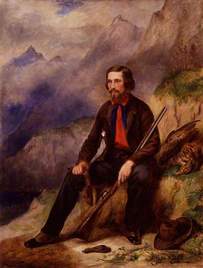 Robert Ballantyne by his brother John Robert Ballantyne by his brother John Robert Michael Ballantyne was born in Edinburgh 24 April 1825, the ninth child of ten, and his brother John's junior by ten years. Largely educated at home by his mother and older siblings his adventures truly began at 16 when he signed up for a five year stint with the Hudson Bay Company in Canada. The experiences he gained of trading furs with the Indians and travelling by sled and canoe were relayed home by letter. These letters and his journal would form the basis for his first published work in 1848 - an autobiographical account of his time spent in Canada "Hudson's Bay or Everyday Life in the Wilds of North America". With the encouragement of his family and publisher William Nelson, he again drew on his experiences to write his first story for boys in 1856 "Snowflakes and Sunbeams or The Young Fur Traders". The success of this book was to mark the beginning a prolific and prosperous writing career. A religious man who aged 24 was elected an Elder of the Free Church of Scotland his Christian principles feature prominently in his writing. He married in 1866 Jane Dickson Grant, a minister's daughter and 21 years his junior with whom he had five children. 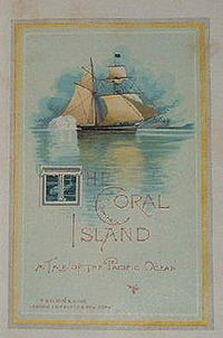 Of all his works Bob Ballantyne is probably best remembered for "The Coral Island: a Tale of The Pacific Ocean" published in 1858. The story of three boys ship-wrecked on a tropical island, complete with pirates and cannibals would prove the inspiration for many other well-known and loved books such as R L Stevenson "Treasure Island", to whom he paid tribute in the preface of the book. It is worthy of note that Bob never forgave himself for his glaring error in his description of coconuts, and vowed from then on to always experience the settings for his books first hand, which he did - even donning a diving suit to get to the bottom of the Thames for his "Under the Waves" in 1876. It is widely reported that having exhausted his own personal experience he turned to those of other published travel accounts for the book's inspiration. Whilst this may be true in part I believe his inspirational source may have lain much closer to home in the exploits of the family of his brother James's wife. I lay out the evidence for this in the following headed section. In 1890 he began to suffer from symptoms of vertigo and the search for a cure took him to Rome in the October 1893. The cure proving to be unsuccessful, Bob Ballantyne died at Via Corso, Rome in February 1894. He is buried in the Non Catholic cemetery there. A beautiful and tranquil spot and in company of other literary greats his tomb was erected by "Four generations of grateful friends in Scotland and England". I could rave about the cemetery at length here, but to do it any sort of justice the cemetery and the team entrusted with its care deserve a blog of their own - Amanda & Lorna many thanks - watch this space! Another brilliant Ballantyne and the eldest of the ten, James Robert Ballantyne was born in December 1813 in Kelso. Educated firstly at Kelso Grammar School, Edinburgh Academy and then Edinburgh College where he began his study of oriental languages which he went on to study further at the East India College. He penned his first book in 1838, unlike his brother Robert this was entitled "A Grammar of the Hindustani Language" Hmmm.. I know which I would rather read! The following year he was appointed to teach Hindi and Sanskrit at Scottish Naval & Military Academy in Edinburgh & in 1845 was sent to India to oversee the re-organisation of the Government College in Benares. In 1844 James married Violet Roberton, daughter of William Roberton, farmer at Friars, Kelso, Roxburghshire and his wife Mary Gordon. Together they had two children before her death in India in 1848. It is to Violet's brothers that the attention now turns. The Pacific & A PirateViolet Roberton was born in August 1811, the tenth of twelve children, 5 brothers and 6 sisters. Her father William died in 1840. His will although fairly extensive, is most unusual as it makes mention of only one child - Violet his daughter, unmarried at the time, and his widow Mary Gordon. Where 'on earth' were the other eleven? William was one of an extensive family himself and from many generations of landowning and tenant farmers. Marrying fairly late in life at the age of 41 he quickly made up for lost time and his family simply outgrew the resources that the small farm of Friars could provide. Drawing on distant relatives in high places, i.e. Thomas Cochrane, the future 10th Earl of Dundonald a succession of positions were secured for all William's sons in the Navy. In 1806 his eldest son went to sea, aged 12, his name was Andrew Gordon Roberton. 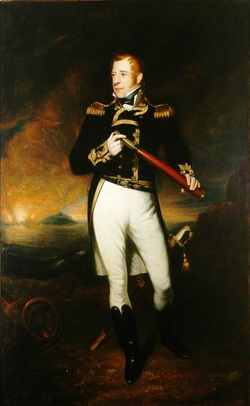 Thomas Cochrane Thomas Cochrane Following the end of the Napoleonic Wars, a subsequent scandal and disgrace left Thomas Cochrane stripped of his titles. Turned mercenary and in charge of the Chilean Navy in its war against Spain, he recruited officers from England to improve the level of seamanship. Andrew Roberton was one of them. Andrew was serving with Thomas in 1820 when the Spanish Flagship "The Esmerelda" was captured at Callao, Peru on the night of the 5th November. Hours before the battle a momentous event occurred that has become the stuff of legend. The wealthy citizens of Lima commissioned a Wiliam Thompson, captain of the "Mary Dear" to transport them and their most valuable possessions to safety in Mexico. The value of the treasure aboard was estimated at $160 million. Unable to resist such temptation Captain Thompson and his crew turned pirate, murdered the guards and set course for Cocos Island where they allegedly buried the loot. Lying low before sharing the spoils Thompson and his crew were captured. Thompson & his first mate were spared the noose in exchange for leading the Spanish to the treasure. Managing to give their captors the slip Thompson and the treasure were never seen again. Enough to give anyone ideas..... By the time Andrew Roberton crossed swords with the notorious pirate Benavides and his lieutenants Pacheo & Martelin in 1822 all his brothers were junior officers in the Chilean Navy. It is believed that during the capture and torture of this band of brigands Andrew gleaned vital information as to the whereabouts of Benavide's treasure horde. Resigning from the Navy and joined by two of his brothers William & James they set off for Mocha Island the site of the treasure & a well known hideout for pirates. The trip proved fruitless and Andrew's brother James was drowned. 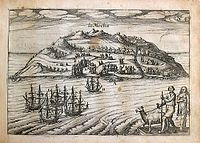 Mocha Island Mocha Island In 1825 Andrew joined the Peruvian Navy and whilst in Lima met & fell in love with the beautiful Theresa Mendez. Alas, his affections were not returned not least for his lack of wealth but of his physical attributes. A first hand account of Andrew described him as "exceedingly bold, having an impetuous and fiery manner with an evident cruel streak. He was of medium height, had red hair and a wild look. He was not exactly ugly, but he was not a nice sight. He had the grin of a hyena." Undeterred believing money would change her mind, Roberton needed a get rich quick scheme. His opportunity came in the form of British vessel the "Peruvian" loaded with 2 million pesetas of military pay. (Today this would be worth in the region of $300 million). Seizing the moment Andrew boarded the poorly guarded ship and he and his crew (including brothers William & George) were long gone by morning. 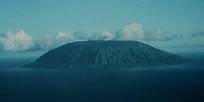 After a spell in Tahiti, Andrew selected the small uninhabited island of Agrihan to bury his booty. Having marked nearby rocks and trees they set sail for Hawaii to dispose of the ship. With their 100,000 gold coins kept back from their stash the brothers set about sinking the "Peruvian" with her remaining crew. On the pretext that they were shipwrecked sailors they rowed to shore & were welcomed in Hawaii by the natives. However, they had failed to scuttle the ship which drifted for some weeks before being spotted by a whaler who rescued a single survivor barely alive. The whaler being on the way out of port it was a full year before the story came out and the perpetrators became known. From Hawaii to Rio de Janeiro with the idea of returning to Scotland, their new found wealth and charms of Rio changed their minds. Andrew & William boarded a vessel to Sydney with the intention of recovering the treasure. George remained in Rio and nothing more is known about him but it is believed he met a watery end. Having chartered a ship with the purpose of the recovery of his treasure, the Governor of the Philippines got wind of his plans and sent a ship and captured Andrew. Alas for Andrew, amongst the ships crew were old friends Pacheo and Martelin who had not forgotten the beating they had received from him in 1822! Tortured to the point of death Andrew finally agreed to take them to site of the treasure. Revived and wrapped in chains realising the no win situation in which he found himself, he threw himself overboard and sank to the bottom. The year was 1826. Meanwhile another Roberton was sailing the Pacific .......to be continued. What has she got to do with it all?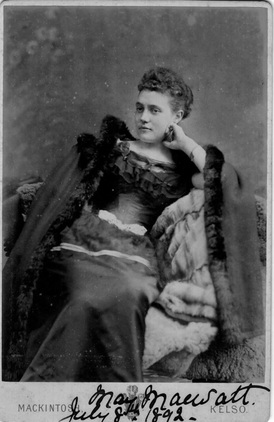 Good question. When I first wrote about May (Mary Alice) back in February of this year, little did I think I would be including her in a blog about a pirate!. She deserves to be linked to the other families of Purves & Hogarth in her own right. Her paternal Grandmother was Alice Purves, sister to James Purves the father of James Charles Purves who died at Scutari. Alice was also sister to Elizabeth Purves, the mother of the Hogarths lost at sea in the disaster of the Royal Charter, and of Christina Alice who married John Ballantyne. May's uncle Rev James McWatt cemented the Purves connection by marrying his first cousin Johanna Purves, sister to our Crimean Hero! The flip side of the coin is that May's maternal grandmother was Mary Roberton, first cousin to the above mentioned pirate and his brothers, and of course to their sister Violet who married James Robert Ballantyne the orientalist. May's grandmother Mary Roberton was the daughter of Andrew Roberton farmer at Ladyrig near Kelso. Genealogy really can throw up some amazing & unexpected connections! ConclusionIn this blog I have barely skimmed the surface on the escapades of the Roberton brothers, particularly those of Andrew Gordon Roberton and his pirate connotations. They are widely documented and below I have posted some links to sites which tell both sides of the story. I have relied most on the very detailed account in the book "Murder in Paradise" by J C M Cresswell which alas, is not widely available. Tracing Robertons from a genealogical perspective is more difficult than most as the name is so often mis-spelt as Robertson. Even the Oxford DNB has James Robert Ballantyne married to a Violet Robertson. That these escapades would have come to the attention of Robert Ballantyne the author is unquestionable as in 1839 a statement was published by Kelso's recorder John Mason which hints strongly with the lines "although clouds rest upon what was in reality his ultimate fate, there is little doubt that it was an unhappy one" that he knew far more than he was prepared to publish. Links as promised
http://books.google.co.uk/books?id=6iYYAAAAYAAJ&pg=PA351&lpg=PA351&dq=Roberton+the+Pirate&source=bl&ots=xlLvnhakDn&sig=8yS-WxQsReJ3AtjLFLjEOdwr9qo&hl=en&sa=X&ei=pZ3lUazlB_Ts0gWF4oHoDg&ved (starts on page 350) http://www.treasurestories.com/Pacific/AgrihanIsland.htm If you haven't read The Coral Island below is a link which will take you to the free ebook http://www.gutenberg.org/catalog/world/readfile?fk_files=1443102&pageno=1 Last but by no means least - if you are ever in Rome I can highly reccommend a visit to the Non-Catholic Cemetery http://www.cemeteryrome.it/index.html
6 Comments
|
AuthorSusie Douglas Archives
August 2022
Categories |
Copyright © 2013 Borders Ancestry
Borders Ancestry is registered with the Information Commissioner's Office No ZA226102 https://ico.org.uk. Read our Privacy Policy
